September 26th, 2008
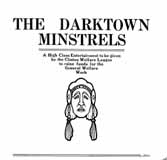 In the early part of the twentieth century, many Clintonville organizations and churches held minstrel shows, as fundraisers and for entertainment. I chose not to sanitize minstrel shows from my book, because they were an authentic part of Clintonville’s history, albeit the part we are all glad we’ve done away with. I regret any offense or hurt caused by these pictures.
In the early part of the twentieth century, many Clintonville organizations and churches held minstrel shows, as fundraisers and for entertainment. I chose not to sanitize minstrel shows from my book, because they were an authentic part of Clintonville’s history, albeit the part we are all glad we’ve done away with. I regret any offense or hurt caused by these pictures.
Tags: Clinton League
Posted in 1900-1940, Organizations, Parks & Recreation | No Comments »
September 26th, 2008
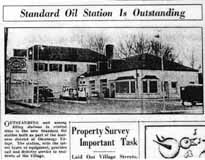 This cute gas station was located at the northern end of the Olentangy Village shopping area in 1939. Today, it is Oldskool restaurant. Is today’s restaurant the same (original) building? I think so. (Photo courtesy of Melissa Goodrich)
This cute gas station was located at the northern end of the Olentangy Village shopping area in 1939. Today, it is Oldskool restaurant. Is today’s restaurant the same (original) building? I think so. (Photo courtesy of Melissa Goodrich)
Posted in Businesses, Transportation | 1 Comment »
September 26th, 2008
 Old maps show at least 3 “Indian springs” within Clintonville. Overbrook Ravine, one of the Indian springs, was untamed and picturesque. Lore has it that Indians harvested cranberries along the brook. (Photo courtesy of Galen Gonser)
Old maps show at least 3 “Indian springs” within Clintonville. Overbrook Ravine, one of the Indian springs, was untamed and picturesque. Lore has it that Indians harvested cranberries along the brook. (Photo courtesy of Galen Gonser)
Posted in 1900-1940 | No Comments »
September 26th, 2008
 Joe Gratziano owned this market on the corner of North Broadway and High Street. It was a one-story brick building. Until quite recently, this building was still there but covered up. Note the house to the south of Gratziano’s, which exists today. Clinton Theatre had not yet been built.
Joe Gratziano owned this market on the corner of North Broadway and High Street. It was a one-story brick building. Until quite recently, this building was still there but covered up. Note the house to the south of Gratziano’s, which exists today. Clinton Theatre had not yet been built.
Gratziano—or his descendants—eventually moved the market farther south on North High Street. One of the residents on West Como told me that the Gratziano family also operated a market in a building along what is now an alley between Como and Lakeview, north of Milton.
Posted in 1900-1940, Businesses | No Comments »
September 26th, 2008
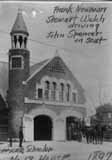 This photograph shows the original Engine House 13 (Originally called Chemical House #2) which was located at the southeast corner of North High Street and Wilcox. Built in 1892, it was a 2-bay station with a hose and belltower. In 1898 an addition was built on the station to accommodate a new steamer.
This photograph shows the original Engine House 13 (Originally called Chemical House #2) which was located at the southeast corner of North High Street and Wilcox. Built in 1892, it was a 2-bay station with a hose and belltower. In 1898 an addition was built on the station to accommodate a new steamer.
Tags: North Columbus
Posted in 1900-1940 | 1 Comment »
September 26th, 2008
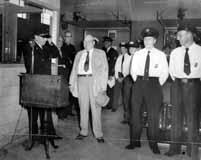 The current Engine House #13 was dedicated on September 1, 1957, and is located at Arcadia and Deming. Architect of the current building is Freshwater and Harrison. This is a photograph of the dedication. (Photo courtesy of Central Ohio Fire Museum)
The current Engine House #13 was dedicated on September 1, 1957, and is located at Arcadia and Deming. Architect of the current building is Freshwater and Harrison. This is a photograph of the dedication. (Photo courtesy of Central Ohio Fire Museum)
Posted in 1940-present | No Comments »
September 26th, 2008
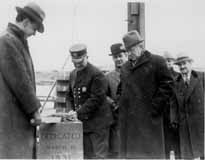 Station #19—known locally as the Northmoor Engine House– was the only Columbus fire station built during the Great Depression. It was built in between 1930 and 1931 for $39,887. Architecturally, the colonial revival building was intended to blend into the neighborhood—and it did so quite well. The building was dedicated on March 10, 1931 (shown). The station motto is “The Pride on High” and a lion is the mascot logo.
Station #19—known locally as the Northmoor Engine House– was the only Columbus fire station built during the Great Depression. It was built in between 1930 and 1931 for $39,887. Architecturally, the colonial revival building was intended to blend into the neighborhood—and it did so quite well. The building was dedicated on March 10, 1931 (shown). The station motto is “The Pride on High” and a lion is the mascot logo.
The engine house soon became too small to accommodate larger fire apparatus and engines had to be special ordered short and low to fit into the station’s small bays. At some point in time, the original bifold doors were replaced by overhead doors; a local resident stored the bifold doors and returned them for the latest, 2003, expansion. (Photo courtesy of Central Ohio Fire Museum)
Anyone out there recall the wonderful old log chairs that used to sit outside of the Northmoor fire station? Lore has it that they were made by prisoners at the old Ohio Penitentiary. Nowadays the few log chairs that remain in Clintonville are stored in the basement of the Northmoor station.
 In the 1950s, The Columbus Dispatch ran an annual holiday decorating contest. The Northmoor fire house won several years in a row. (Photo courtesy of Central Ohio Fire Museum)
In the 1950s, The Columbus Dispatch ran an annual holiday decorating contest. The Northmoor fire house won several years in a row. (Photo courtesy of Central Ohio Fire Museum)
Posted in 1900-1940 | No Comments »
September 26th, 2008
There were A&P’s located at several locations in Clintonville. An A&P used to be located where Blockbuster at Hudson and High Street is today. The Great American Tea Company began in the mid-1800s selling tea, coffee and spices at value prices in New York City. In 1870 the company was renamed the Great Atlantic & Pacific Tea Company, in honor of the first transcontinental railroad and hopes of expanding across the continent. It was the first national supermarket chain in the United States; by 1930 it had 16,000 stores. The company pioneered “frequent customer” programs; one of its most popular programs was plaid stamps. I remember saving up stamps and pasting them into coupon books to redeem them for things like Lazy Susans. In 1980 the company underwent a restructuring and the Tengelmann Group owns controlling interest.
Posted in 1900-1940, Businesses | No Comments »
September 26th, 2008
Dallas Dupre, whose son still lives in Greater Columbus, was a landscape architect. He had an office located on the west side of North High Street near Weber Road (3073 North High Street), and is reputed to have been the founder of the early roadside park system throughout the U.S. The Dupre family lived in old Beechwold.
Posted in 1900-1940, People, Transportation | No Comments »
September 26th, 2008
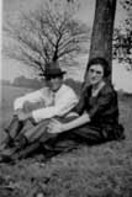 I loved the story of Lawrence Huber (1893-1958) and his wife Eunice Louise Dougherty (1900-1986). Lawrence had applied for a job at the Elks Country Club. They told him they wanted the incumbent to be married, so he asked his girlfriend Eunice to marry him. She accepted and they married in 1922–and remained married the rest of thier lives.
I loved the story of Lawrence Huber (1893-1958) and his wife Eunice Louise Dougherty (1900-1986). Lawrence had applied for a job at the Elks Country Club. They told him they wanted the incumbent to be married, so he asked his girlfriend Eunice to marry him. She accepted and they married in 1922–and remained married the rest of thier lives.
Huber, under the direction of Donald Ross, helped to construct the Elks Country Club golf course, which was located north of Morse Road and east of High Street to Indianola Road. Huber eventually took  over the position of groundskeeper when the course opened the following year. Lawrence and Eunice, and their three children, lived in a residence on the Elks Country Club property while Lawrence was employed there. Huber was extremely innovative, and invented equipment as needed to cultivate and care for the greens. (Photo courtesy of Betty Huber)
over the position of groundskeeper when the course opened the following year. Lawrence and Eunice, and their three children, lived in a residence on the Elks Country Club property while Lawrence was employed there. Huber was extremely innovative, and invented equipment as needed to cultivate and care for the greens. (Photo courtesy of Betty Huber)
Posted in 1900-1940, Houses, Parks & Recreation, People | 1 Comment »
 In the early part of the twentieth century, many Clintonville organizations and churches held minstrel shows, as fundraisers and for entertainment. I chose not to sanitize minstrel shows from my book, because they were an authentic part of Clintonville’s history, albeit the part we are all glad we’ve done away with. I regret any offense or hurt caused by these pictures.
In the early part of the twentieth century, many Clintonville organizations and churches held minstrel shows, as fundraisers and for entertainment. I chose not to sanitize minstrel shows from my book, because they were an authentic part of Clintonville’s history, albeit the part we are all glad we’ve done away with. I regret any offense or hurt caused by these pictures. 
 Old maps show at least 3 “Indian springs” within Clintonville. Overbrook Ravine, one of the Indian springs, was untamed and picturesque. Lore has it that Indians harvested cranberries along the brook. (Photo courtesy of Galen Gonser)
Old maps show at least 3 “Indian springs” within Clintonville. Overbrook Ravine, one of the Indian springs, was untamed and picturesque. Lore has it that Indians harvested cranberries along the brook. (Photo courtesy of Galen Gonser) Joe Gratziano owned this market on the corner of North Broadway and High Street. It was a one-story brick building. Until quite recently, this building was still there but covered up. Note the house to the south of Gratziano’s, which exists today. Clinton Theatre had not yet been built.
Joe Gratziano owned this market on the corner of North Broadway and High Street. It was a one-story brick building. Until quite recently, this building was still there but covered up. Note the house to the south of Gratziano’s, which exists today. Clinton Theatre had not yet been built. 

 Station #19—known locally as the Northmoor Engine House– was the only Columbus fire station built during the Great Depression. It was built in between 1930 and 1931 for $39,887. Architecturally, the colonial revival building was intended to blend into the neighborhood—and it did so quite well. The building was dedicated on March 10, 1931 (shown). The station motto is “The Pride on High” and a lion is the mascot logo.
Station #19—known locally as the Northmoor Engine House– was the only Columbus fire station built during the Great Depression. It was built in between 1930 and 1931 for $39,887. Architecturally, the colonial revival building was intended to blend into the neighborhood—and it did so quite well. The building was dedicated on March 10, 1931 (shown). The station motto is “The Pride on High” and a lion is the mascot logo. In the 1950s, The Columbus Dispatch ran an annual holiday decorating contest. The Northmoor fire house won several years in a row. (Photo courtesy of Central Ohio Fire Museum)
In the 1950s, The Columbus Dispatch ran an annual holiday decorating contest. The Northmoor fire house won several years in a row. (Photo courtesy of Central Ohio Fire Museum) I loved the story of Lawrence Huber (1893-1958) and his wife Eunice Louise Dougherty (1900-1986). Lawrence had applied for a job at the Elks Country Club. They told him they wanted the incumbent to be married, so he asked his girlfriend Eunice to marry him. She accepted and they married in 1922–and remained married the rest of thier lives.
I loved the story of Lawrence Huber (1893-1958) and his wife Eunice Louise Dougherty (1900-1986). Lawrence had applied for a job at the Elks Country Club. They told him they wanted the incumbent to be married, so he asked his girlfriend Eunice to marry him. She accepted and they married in 1922–and remained married the rest of thier lives.  over the position of groundskeeper when the course opened the following year. Lawrence and Eunice, and their three children, lived in a residence on the Elks Country Club property while Lawrence was employed there. Huber was extremely innovative, and invented equipment as needed to cultivate and care for the greens. (Photo courtesy of Betty Huber)
over the position of groundskeeper when the course opened the following year. Lawrence and Eunice, and their three children, lived in a residence on the Elks Country Club property while Lawrence was employed there. Huber was extremely innovative, and invented equipment as needed to cultivate and care for the greens. (Photo courtesy of Betty Huber)